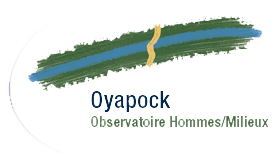

Laureate of the Laboratory for Excellence project (LabEx) in the program « Investment in the future », the DRIIHM LabEx, InterDisciplinary Research Facility on Human-Environment Interactions, aggregate 131 human-environments observatories (OHM in french), tools for observing socio-ecosystems impacted by anthropic events. Created by CNRS-INEE in 2007, they are located in metropolitan France (6: Bassin Minier de Provence (provence Coalfield), Pyrénées-haut Vicdessos, Vallée du Rhône (Rhone valley), Littoral Méditerranéen (French mediterranean coastal zone), Pays de Bitche (Bitche County) and Fessenheim), overseas France (2: Oyapock (French Guyana), Littoral caraïbe (Caribbean Coast)) and abroad (5: Estarreja (Portugal), Téssékéré (Sénégal), Nunavik (Canada), Pima County (USA), Patagonia-Bahia Exploradores (Chile)).
DRIIHM brings together over 1,400 research staff, including 300 foreigners, from 200 research units in 87 french and foreign universities, 46 research organizations and "Grandes Écoles". It has financed 960 research projects, supervised 190 doctorates, 110 post-doctorates and over 400 Master's degrees.
 The Aveiro University (UA), the Instituto Superior Técnico (IST) and the International Medical Geology Association (IMGA) co-organize the 6th International Conference on Medical Geology, the emerging interdisciplinary scientific field "dealing with the influence of ordinary environmental factors on the geographical distribution of health problems in man and animals" according to the Commission on Geological Sciences for Environmental Planning.
The Aveiro University (UA), the Instituto Superior Técnico (IST) and the International Medical Geology Association (IMGA) co-organize the 6th International Conference on Medical Geology, the emerging interdisciplinary scientific field "dealing with the influence of ordinary environmental factors on the geographical distribution of health problems in man and animals" according to the Commission on Geological Sciences for Environmental Planning.
This event will take place from 26th July to the 1st August 2015.
MEDGEO conference bring together researchers and decision makers from the physical sciences and the medical sciences who are interested in solving health problems caused by natural processes and materials. The participants of the conference will convey expertise in a range of scientific fields, such as geochemistry, biology, engineering, geology, hydrology, epidemiology, chemistry, medicine, nutrition and toxicology.
Click on MedGeo2015 (http://medgeo15.web.ua.pt/) to learn more about Registration, Deadlines and Scientific Program.
Listen or listen again Pod-Cast Planette Terre by Sylvain Kahn, released Wednesday, 02/25/15 on France Culture: The relationship of humanity to nature can they evolve?
Given the critical state of biodiversity and exclusively mercantile relations and reified for much of human society to nature, is it possible to hope for a paradigm shift? Can we hope to take education very integrated and egalitarian relationships that companies have with améridiennes Nature? Ethics and proposed scientific solutions they can to change the economic and political pre-eminence?
According to Philippe Descola: "There are three matters critical to deal with the current crisis: ecology, anthropology and geography For these are the three science of interactions between humans and non-humans, they should occupy a very great.. place in secondary education."
Guest(s):
October 20-24, 2015 - Kerkennah archipelago, Sfax (Tunisia)
The Mediterranean area undergoes different climatic influences and is known to be a climatic change hotspot by the IPCC. Indeed the climate change and sea level evolution are important there. It is also an ancient anthropised area where the actual population growth in the coastal area is important. High human densities imply high issues: touristic, economic, heritage, natural etc. Consequences on that area, natural and directly or indirectly anthropogenic ask new problematic. This symposium offers to consider on three of them:
The geoarchaeology of mediterranean islands. Multidisciplinary approaches to paleoenvironmental changes and the history of the human occupation in the Mediterranean islands since the Last Glacial Maximum
Cette manifestation dont l'OHM Littoral méditerranéen est partenaire se déroulera du 30 juin au 2 juillet au Centre de congrès CNRS de Cargèse (Corse, France).
L'inscription (en ligne, ICI) est obligatoire en raison du nombre limité de places.
Pour en savoir plus, consulter le site de la rencontre à cette adresse : http://www.geomedislands.org/
 For over 20 years, the science comes your way.
For over 20 years, the science comes your way.
The Science Festival takes place this year in France (and now international) from 27 September to 19 October. It is an opportunity to "discover the world of science and meet the men and women who are today's science." This is an opportunity for young and old to learn, to dare ask questions to those who practice everyday science.
In their objectives "to bring knowledge," opening to civil society and environmental education, the OHM participate again in this event.
You will find below, the activities organized under the Science Festival 2014, as and when they are completed.
OHM Oyapock : September 29 evening, Damien Davy, anthropologist, director of the OHM Oyapock, presented on the seafront in Kourou few examples of astral representations and myths that shape the memories and knowledge of Amerindians from Guyana.

The article "And so came the two brothers Kusuwi" details his response.
 Sandra Nicolle defended his doctoral thesis entitled "Protected natural areas in the Amazon rainforest Doctrines management devices. How effectively for environmental protection comparative study France (French Guiana) / Brazil (Amapá) ?", wednesday, september 24 2014, 15h, at the AgroParisTech center of Montpellier (648 rue Jean-François Breton), Amazon room.
Sandra Nicolle defended his doctoral thesis entitled "Protected natural areas in the Amazon rainforest Doctrines management devices. How effectively for environmental protection comparative study France (French Guiana) / Brazil (Amapá) ?", wednesday, september 24 2014, 15h, at the AgroParisTech center of Montpellier (648 rue Jean-François Breton), Amazon room.
 The animation of the secretariat of Future Earth has been awarded to an international consortium of France, the USA, Japan, Canada and Sweden. According to Michel Jarraud (WMO) as a consortium "strengthen the program's ability to build bridges between the communities of researchers and practitioners internationally." For France, ANR, alongside the Ministry of National Education, Higher Education and Research and Allenvi alliance, is an integral part of the secretariat.
The animation of the secretariat of Future Earth has been awarded to an international consortium of France, the USA, Japan, Canada and Sweden. According to Michel Jarraud (WMO) as a consortium "strengthen the program's ability to build bridges between the communities of researchers and practitioners internationally." For France, ANR, alongside the Ministry of National Education, Higher Education and Research and Allenvi alliance, is an integral part of the secretariat.
Learn more : FuturEarth News
Page 11 of 12